Intel D45SG Extreme Series Review
Intel D45SG Extreme Series
It's extreme by name but is it extreme by nature? Leo finds out.
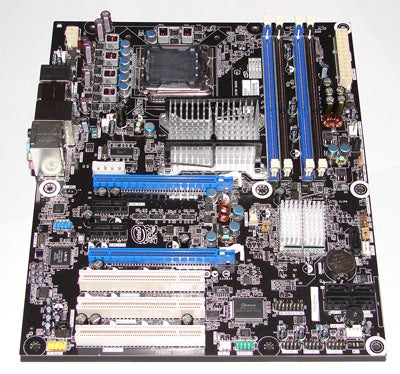
Verdict
Key Specifications
- Review Price: £101.11
The D45SG is part of Intel’s Extreme Series of desktop motherboards and that makes it rather interesting. There are seven Extreme motherboards with each model built around a different chipset. These include the 975X based BadAxe D975XBX2 (our test bench motherboard for quite a while), the D5400XS that is a workstation board adapted for gamers and codenamed Skulltrail. Then there’s the DX58SO Smackover that’s the current Core i7 model and a couple of other Core 2 boards; the DX38BT and the DX48BT2.
This leaves the DG41TY, which is built on a G41 chipset. Now, we like G41 well enough but the very idea that any G41 motherboard qualifies as ‘Extreme’ is absurd as G41 is a budget chipset that is intended to support the junior members of the Core 2 family with the minimum of expense, not provide extreme performance.
And so we come to the DG45SG which is a P45 chipset motherboard that supports Core 2 CPUs with dual PCI Express 2.0 x16 graphics slots and CrossFire. With a price tag just above the £100 mark this positions the DP45SG way, way down the scale from the £200 DX38BT/DX48BT2 models with triple graphics slots.
We can regard the DG45SG as Intel’s reference design for an economical gamer’s motherboard that makes the most of the features in the P45 chipset. Its LGA775 socket supports every Core 2 processor under the sun (apart from the exotic QX9770) along with a handful of 3000 series Xeons. The lack of support for QX9770 gives the clue to Intel’s way of thinking as the P45 chipset does not officially support the 1,600MHz front side bus used by QX9770. Every Taiwanese motherboard manufacturer has managed to add unofficial support for the faster front side bus but Intel, not surprisingly, is obliged to stick to the rules that it wrote.
We don’t much care about support for the £1,000 Core 2 Extreme QX9770 but Intel continues its thinking to the memory and that’s more of an issue. The four memory slots support DDR3 but the speeds are limited to 800MHz, 1,066MHz and 1,333MHz with no option of going any faster. You’d be hard-pressed to find a Taiwanese P45 motherboard that doesn’t support 1,600MHz or faster.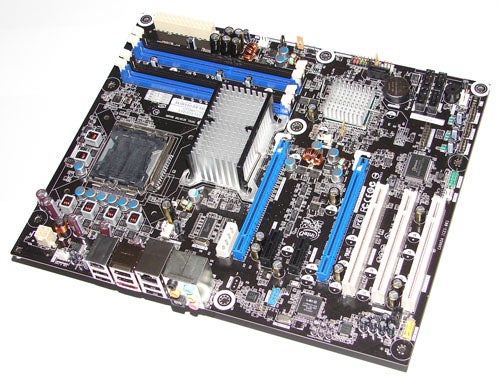
When it comes to ports and connectors Intel has completely ditched support for legacy connections like floppy and IDE. Every other motherboard with a P35 or P45 chipset has an additional controller chip from the likes of JMicron that allows the option of an IDE optical drive but once again Intel is sticking to its guns. Legacy support is a Bad Thing so the only option for your new build is a SATA DVD drive.
The ICH10R Southbridge supports six SATA devices which Intel has chosen to divide with five internal SATA ports and one eSATA port on the I/O panel. The five ports all stand vertically which is far less convenient than having them laid down at the edge of the board and the location of the connectors is highly questionable as well. The problem centres on the second graphics slot. If you run two chunky graphics cards in CrossFire you will find that one or two SATA connectors are blocked and if you’re the man in a million who runs a pair of Radeon 4870 X2 graphics cards you’ll struggle to find two SATA connectors that are usable.
The I/O panel brings a new dimension to the word minimal. Naturally there is no sign of old school Serial and Parallel ports but Intel has gone further and has also ditched the PS/2 ports. Unfortunately Intel has decided that six USB 2.0 ports are sufficient which seems like poor judgement as you’ll need two of the ports just for your mouse and keyboard. There are headers for six more USB ports but no brackets are included in the package.
The Gigabit Ethernet is powered by Intel silicon and the Dolby HD audio chip comes from IDT (Integrated Device Technology). Intel has added to the features provided by the P45 chipset by adding an LSI Firewire controller with one port on the I/O panel and a header for a second port on the board.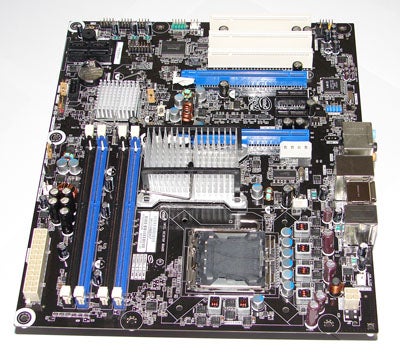
Our initial attempts to benchmark the DP45DG caused a certain amount of frustration as we were expecting the board to behave like the DX38BT, DX48BT2, DX58SO and D975XBX2. This was optimistic and we should have spotted the signs; the DP45SG doesn’t have a micro button for Power but it does have an on board speaker that beeps during POST and again as the Operating System loads in a manner somewhat reminiscent of R2D2 (well at least it’s not C3PO – ed.). These signs proved to be indications that the DP45SG is not quite as serious as it first appears.
We started by running the DP45SG at default speeds using version 0112 of the BIOS. Although the BIOS correctly reported the speed of our Core 2 Duo E8500 as 9.5 x 333MHz = 3.16GHz we found that performance was rather low. A quick investigation revealed that the front side bus was set at 266MHz, despite the BIOS saying otherwise, with the result that the CPU was running at 2.5GHz. We were able to set the front side bus speed manually but that meant that we had to contend with the warning message in the Performance section of the BIOS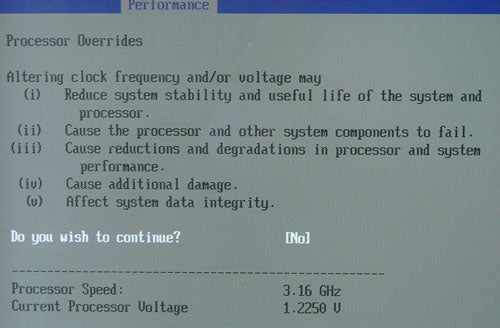
(centre)”’Anyone would think that Intel doesn’t want to encourage overclocking – say it ain’t so.”’(/centre)
We updated to BIOS 0116 and found that the CPU speed recovered to the correct level but that wasn’t the end of our troubles.
You only get three settings for memory speed (800MHz, 1066MHz and 1333MHz) however those speeds only apply with the front side bus set at 333MHz (at least in the case of the Core 2 Duo E8500). When you raise the FSB the memory speed options in the BIOS remain the same although the speeds do actually change in step with the front side bus so it is clear that the three speeds actually relate to a memory multiplier. Once you figure that out you might feel brave enough to select one of the settings but we found that any change in this department resulted in a system that is horribly unstable and prone to locking up. The only safe approach we could find was to leave the memory speed on Auto and to ramp up the front side bus. The upshot was that the Extreme DP45SG ran slightly faster than the MSI P45C Neo-FIR although performance was a tad lower which doesn’t sound particularly Extreme to our way of thinking.
”’Verdict”’
Although the DP45SG sports the Extreme logo it is actually just a dual graphics slot toting, Crossfire supporting, budget P45 motherboard. We suppose the ”Mundane!” range wouldn’t quite have had the same effect.
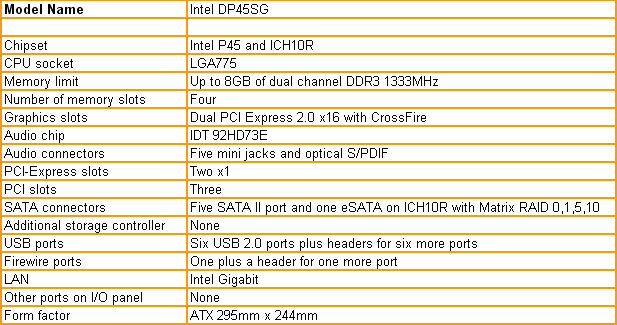
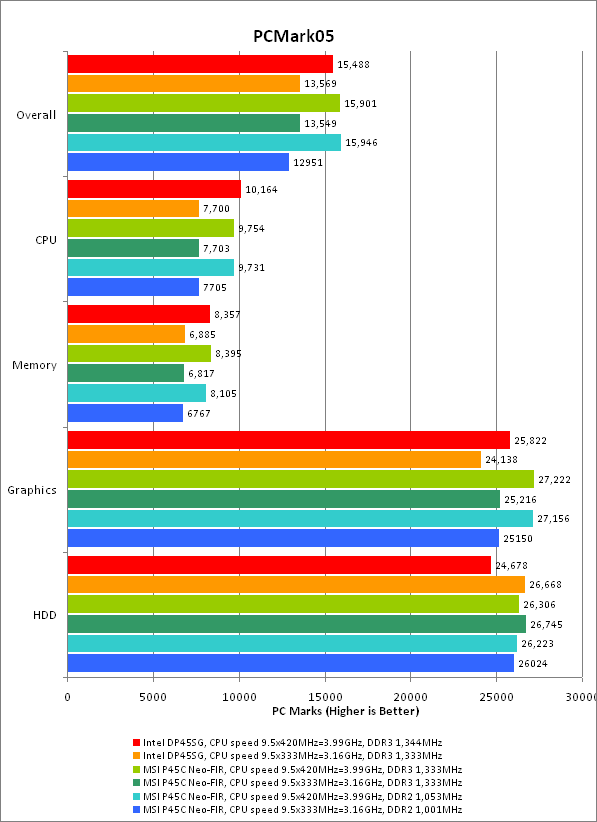
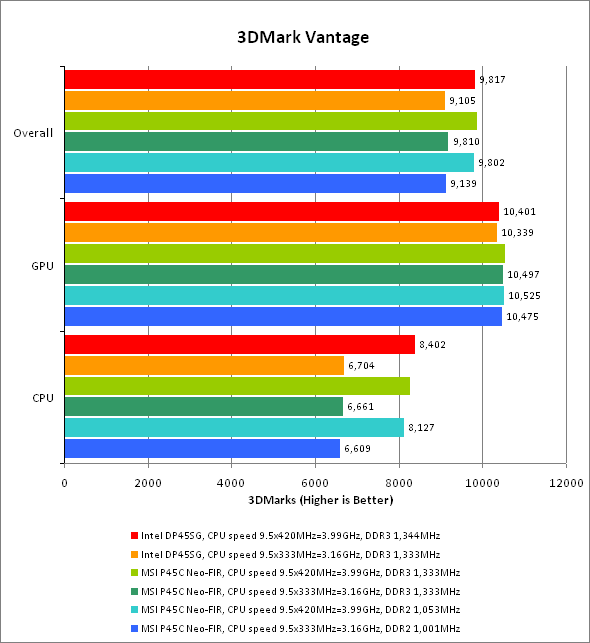
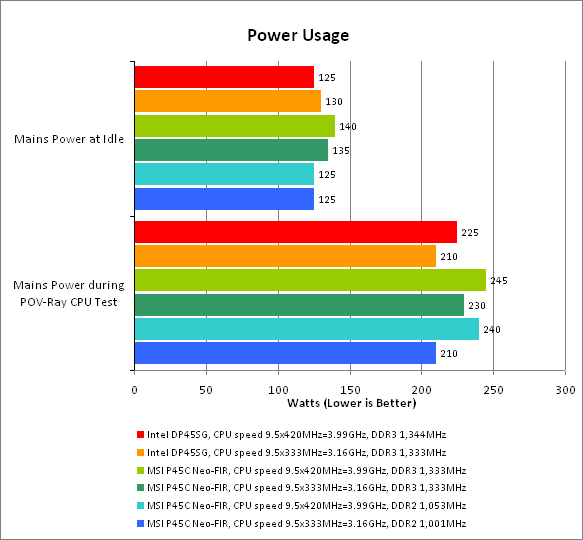
Trusted Score
Score in detail
-
Value 7
-
Performance 7

